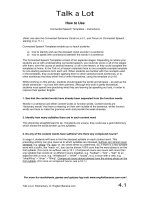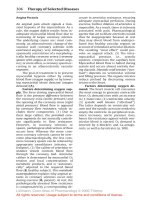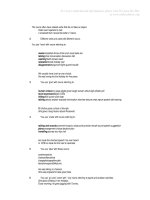Tài liệu Color Atlas of Pharmacology (Part 6): Quantification of Drug Action ppt
Bạn đang xem bản rút gọn của tài liệu. Xem và tải ngay bản đầy đủ của tài liệu tại đây (325.39 KB, 6 trang )
Dose–Response Relationship
The effect of a substance depends on the
amount administered, i.e., the dose. If
the dose chosen is below the critical
threshold (subliminal dosing), an effect
will be absent. Depending on the nature
of the effect to be measured, ascending
doses may cause the effect to increase in
intensity. Thus, the effect of an antipy-
retic or hypotensive drug can be quanti-
fied in a graded fashion, in that the ex-
tent of fall in body temperature or blood
pressure is being measured. A dose-ef-
fect relationship is then encountered, as
discussed on p. 54.
The dose-effect relationship may
vary depending on the sensitivity of the
individual person receiving the drug,
i.e., for the same effect, different doses
may be required in different individuals.
Interindividual variation in sensitivity is
especially obvious with effects of the
“all-or-none” kind.
To illustrate this point, we consider
an experiment in which the subjects in-
dividually respond in all-or-none fash-
ion, as in the Straub tail phenomenon
(A). Mice react to morphine with excita-
tion, evident in the form of an abnormal
posture of the tail and limbs. The dose
dependence of this phenomenon is ob-
served in groups of animals (e.g., 10
mice per group) injected with increas-
ing doses of morphine. At the low dose,
only the most sensitive, at increasing
doses a growing proportion, at the high-
est dose all of the animals are affected
(B). There is a relationship between the
frequency of responding animals and
the dose given. At 2 mg/kg, one out of 10
animals reacts; at 10 mg/kg, 5 out of 10
respond. The dose-frequency relation-
ship results from the different sensitiv-
ity of individuals, which as a rule exhib-
its a log-normal distribution (C, graph at
right, linear scale). If the cumulative fre-
quency (total number of animals re-
sponding at a given dose) is plotted
against the logarithm of the dose (ab-
scissa), a sigmoidal curve results (C,
graph at left, semilogarithmic scale).
The inflection point of the curve lies at
the dose at which one-half of the group
has responded. The dose range encom-
passing the dose-frequency relationship
reflects the variation in individual sensi-
tivity to the drug. Although similar in
shape, a dose-frequency relationship
has, thus, a different meaning than does
a dose-effect relationship. The latter can
be evaluated in one individual and re-
sults from an intraindividual dependen-
cy of the effect on drug concentration.
The evaluation of a dose-effect rela-
tionship within a group of human sub-
jects is compounded by interindividual
differences in sensitivity. To account for
the biological variation, measurements
have to be carried out on a representa-
tive sample and the results averaged.
Thus, recommended therapeutic doses
will be appropriate for the majority of
patients, but not necessarily for each in-
dividual.
The variation in sensitivity may be
based on pharmacokinetic differences
(same dose Ǟ different plasma levels)
or on differences in target organ sensi-
tivity (same plasma level Ǟ different ef-
fects).
52 Quantification of Drug Action
Lüllmann, Color Atlas of Pharmacology © 2000 Thieme
All rights reserved. Usage subject to terms and conditions of license.
Quantification of Drug Action 53
C. Dose-frequency relationship
A. Abnormal posture in mouse given morphine
B. Incidence of effect as a function of dose
Dose = 0 = 2 mg/kg = 10 mg/kg
= 20 mg/kg = 140 mg/kg= 100 mg/kg
mg/kg 2 14010010 20
20
100
40
60
80
% Cumulative frequency
mg/kg2 14010010 20
1
2
3
4
Frequency of dose needed
Lüllmann, Color Atlas of Pharmacology © 2000 Thieme
All rights reserved. Usage subject to terms and conditions of license.
Concentration-Effect Relationship (A)
The relationship between the concen-
tration of a drug and its effect is deter-
mined in order to define the range of ac-
tive drug concentrations (potency) and
the maximum possible effect (efficacy).
On the basis of these parameters, differ-
ences between drugs can be quantified.
As a rule, the therapeutic effect or toxic
action depends critically on the re-
sponse of a single organ or a limited
number of organs, e.g., blood flow is af-
fected by a change in vascular luminal
width. By isolating critical organs or tis-
sues from a larger functional system,
these actions can be studied with more
accuracy; for instance, vasoconstrictor
agents can be examined in isolated
preparations from different regions of
the vascular tree, e.g., the portal or
saphenous vein, or the mesenteric, cor-
onary, or basilar artery. In many cases,
isolated organs or organ parts can be
kept viable for hours in an appropriate
nutrient medium sufficiently supplied
with oxygen and held at a suitable tem-
perature.
Responses of the preparation to a
physiological or pharmacological stim-
ulus can be determined by a suitable re-
cording apparatus. Thus, narrowing of a
blood vessel is recorded with the help of
two clamps by which the vessel is sus-
pended under tension.
Experimentation on isolated organs
offers several advantages:
1. The drug concentration in the tissue
is usually known.
2. Reduced complexity and ease of re-
lating stimulus and effect.
3. It is possible to circumvent compen-
satory responses that may partially
cancel the primary effect in the intact
organism — e.g., the heart rate in-
creasing action of norepinephrine
cannot be demonstrated in the intact
organism, because a simultaneous
rise in blood pressure elicits a coun-
ter-regulatory reflex that slows car-
diac rate.
4. The ability to examine a drug effect
over its full rage of intensities — e.g.,
it would be impossible in the intact
organism to follow negative chrono-
tropic effects to the point of cardiac
arrest.
Disadvantages are:
1. Unavoidable tissue injury during dis-
section.
2. Loss of physiological regulation of
function in the isolated tissue.
3. The artificial milieu imposed on the
tissue.
Concentration-Effect Curves (B)
As the concentration is raised by a con-
stant factor, the increment in effect di-
minishes steadily and tends asymptoti-
cally towards zero the closer one comes
to the maximally effective concentra-
tion.The concentration at which a maxi-
mal effect occurs cannot be measured
accurately; however, that eliciting a
half-maximal effect (EC
50
) is readily de-
termined. It typically corresponds to the
inflection point of the concentra-
tion–response curve in a semilogarith-
mic plot (log concentration on abscissa).
Full characterization of a concentra-
tion–effect relationship requires deter-
mination of the EC
50
, the maximally
possible effect (E
max
), and the slope at
the point of inflection.
54 Quantification of Drug Action
Lüllmann, Color Atlas of Pharmacology © 2000 Thieme
All rights reserved. Usage subject to terms and conditions of license.
Quantification of Drug Action 55
B. Concentration-effect relationship
A. Measurement of effect as a function of concentration
Portal vein
Mesenteric artery
Coronary
artery
Basilar
artery
Saphenous
vein
1005040302010521
Vasoconstriction
Active tension
1 min
Drug concentration
Effect
(in mm of registration unit,
e.g., tension developed)
Concentration (linear)
20 30 40 5010
50
40
30
20
10
Effect
(% of maximum effect)
Concentration (logarithmic)
10 1001
100
80
60
40
20
%
Lüllmann, Color Atlas of Pharmacology © 2000 Thieme
All rights reserved. Usage subject to terms and conditions of license.
Concentration-Binding Curves
In order to elicit their effect, drug mole-
cules must be bound to the cells of the
effector organ. Binding commonly oc-
curs at specific cell structures, namely,
the receptors. The analysis of drug bind-
ing to receptors aims to determine the
affinity of ligands, the kinetics of inter-
action, and the characteristics of the
binding site itself.
In studying the affinity and number
of such binding sites, use is made of
membrane suspensions of different tis-
sues. This approach is based on the ex-
pectation that binding sites will retain
their characteristic properties during
cell homogenization. Provided that
binding sites are freely accessible in the
medium in which membrane fragments
are suspended, drug concentration at
the “site of action” would equal that in
the medium. The drug under study is ra-
diolabeled (enabling low concentra-
tions to be measured quantitatively),
added to the membrane suspension,
and allowed to bind to receptors. Mem-
brane fragments and medium are then
separated, e.g., by filtration, and the
amount of bound drug is measured.
Binding increases in proportion to con-
centration as long as there is a negligible
reduction in the number of free binding
sites (c = 1 and B ≈ 10% of maximum
binding; c = 2 and B ≈ 20 %). As binding
approaches saturation, the number of
free sites decreases and the increment
in binding is no longer proportional to
the increase in concentration (in the ex-
ample illustrated, an increase in con-
centration by 1 is needed to increase
binding from 10 to 20 %; however, an in-
crease by 20 is needed to raise it from 70
to 80 %).
The law of mass action describes
the hyperbolic relationship between
binding (B) and ligand concentration (c).
This relationship is characterized by the
drug’s affinity (1/K
D
) and the maximum
binding (B
max
), i.e., the total number of
binding sites per unit of weight of mem-
brane homogenate.
c
B = B
max
· –––––––
c + K
D
K
D
is the equilibrium dissociation con-
stant and corresponds to that ligand
concentration at which 50 % of binding
sites are occupied. The values given in
(A) and used for plotting the concentra-
tion-binding graph (B) result when K
D
=
10.
The differing affinity of different li-
gands for a binding site can be demon-
strated elegantly by binding assays. Al-
though simple to perform, these bind-
ing assays pose the difficulty of correlat-
ing unequivocally the binding sites con-
cerned with the pharmacological effect;
this is particularly difficult when more
than one population of binding sites is
present. Therefore, receptor binding
must not be implied until it can be
shown that
•
binding is saturable (saturability);
•
the only substances bound are those
possessing the same pharmacological
mechanism of action (specificity);
•
binding affinity of different substanc-
es is correlated with their pharmaco-
logical potency.
Binding assays provide information
about the affinity of ligands, but they do
not give any clue as to whether a ligand
is an agonist or antagonist (p. 60). Use of
radiolabeled drugs bound to their re-
ceptors may be of help in purifying and
analyzing further the receptor protein.
56 Quantification of Drug Action
Lüllmann, Color Atlas of Pharmacology © 2000 Thieme
All rights reserved. Usage subject to terms and conditions of license.
Quantification of Drug Action 57
B = 10% B = 20% B = 30%
B = 50% B = 70% B = 80%
B. Concentration-binding relationship
A. Measurement of binding (B) as a function of concentration (c)
Binding (B)
20 30 40 5010
100
80
60
40
20
% Binding (B)
1001
100
80
60
40
20
%
10
Organs
Homogenization
Centrifugation
Membrane
suspension
Mixing and incubation
Addition of
radiolabeled
drug in
different
concentrations
Determination
of radioactivity
c = 1 c = 2 c = 5
c = 10 c = 20 c = 40
Concentration (linear) Concentration (logarithmic)
Lüllmann, Color Atlas of Pharmacology © 2000 Thieme
All rights reserved. Usage subject to terms and conditions of license.









